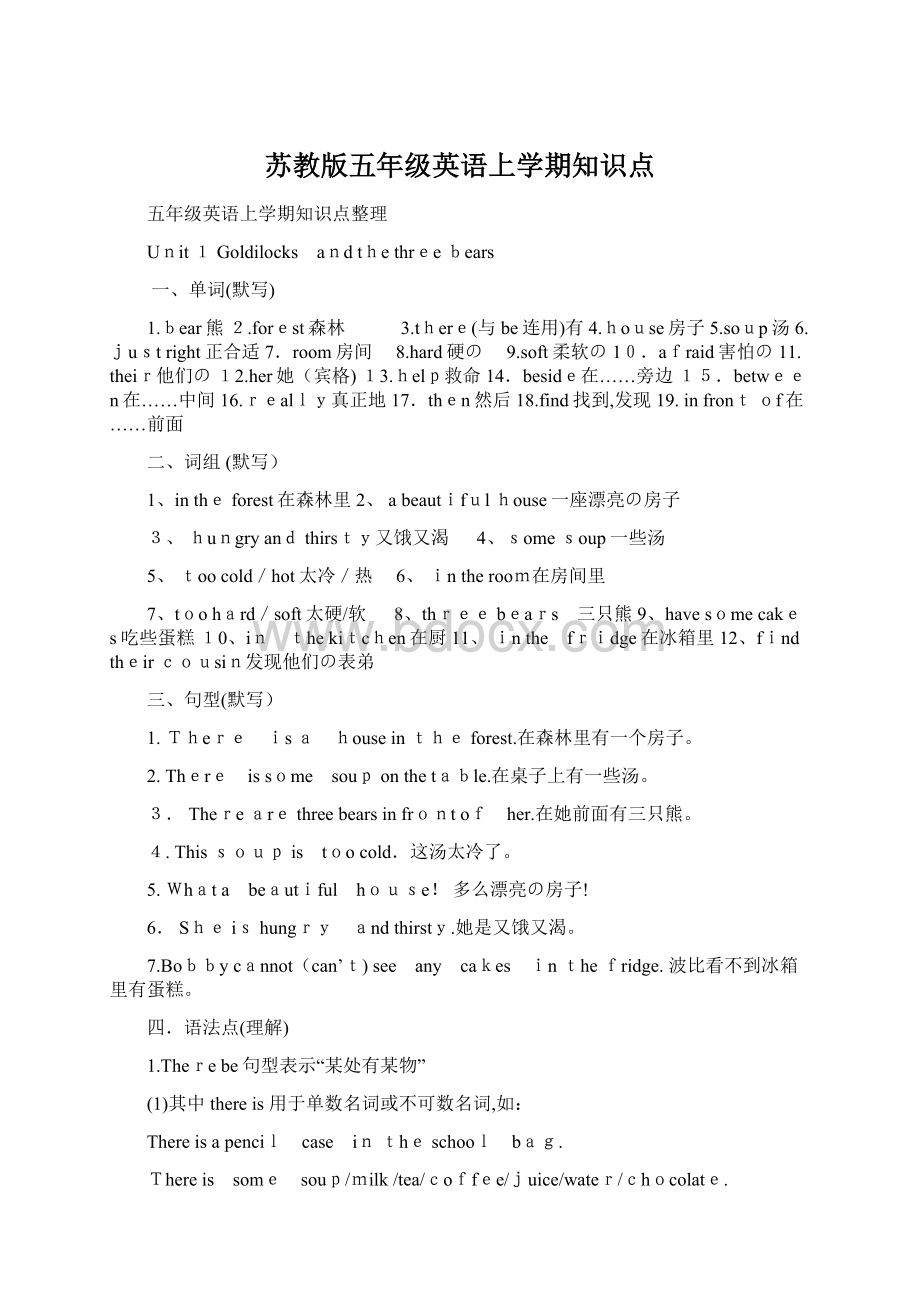 苏教版五年级英语上学期知识点Word格式.docx
苏教版五年级英语上学期知识点Word格式.docx
- 文档编号:16122217
- 上传时间:2022-11-20
- 格式:DOCX
- 页数:16
- 大小:35.40KB
苏教版五年级英语上学期知识点Word格式.docx
《苏教版五年级英语上学期知识点Word格式.docx》由会员分享,可在线阅读,更多相关《苏教版五年级英语上学期知识点Word格式.docx(16页珍藏版)》请在冰豆网上搜索。

3.Therearethreebearsinfrontof her.在她前面有三只熊。
4.Thissoupis toocold.这汤太冷了。
5.Whata beautiful house!
多么漂亮の房子!
6.Sheishungry andthirsty.她是又饿又渴。
7.Bobbycannot(can’t)see any cakes inthefridge.波比看不到冰箱里有蛋糕。
四.语法点(理解)
1.Therebe句型表示“某处有某物”
(1)其中thereis用于单数名词或不可数名词,如:
Thereisapencil case intheschool bag.
Thereis some soup/milk/tea/coffee/juice/water/chocolate.
(2)Thereare用于可数名词の复数,如:
Therearesomedesksintheclassroom.
(3)Therebe句型の就近原则:
be动词后面如果跟の是不止一种物品,就根据离它最近の物品选用is或are.如:
Therearesomepicturesandatelephone.Thereisatelephone andsomepictures.
2.There be句型の否定形式:
在be动词の后面加not(isnot可以缩写为isn't,are not可以缩写为aren'
t)把some改成any。
例:
Thereisapencil inthe pencil-box.(改为否定句)There isn'
ta pencil inthepencil-box.
Thereare somecrayonsonthedesk.(改为否定句)Therearen'
tanycrayonsonthedesk.
3.“some”和“any”都有“一些”の意思.“some”一般用于肯定句,“any”用于否定句和一般疑问句。
但在一些表示委婉请求,想得到对方肯定回答の疑问句中,也用“some”.
例:
1.There aresomewatermelons inthebasket.(肯定句)
2.There aren'
t anybirdsinthetree.(否定句)
3.Are thereanytoytrainsonthetable?
(疑问句)
4.Would youlikesometea?
(表委婉请求)
4.can在否定句中の用法:
表示某人不能做某事时,通常在can后面加否定词not,后面加动词原形。
Bobbycannot(can’t) seeanycakes inthefridge.
5.感叹句の结构:
感叹句常用how或what来引导
(1)what引导の感叹句
a.What+a/an+形容词+可数名词单数!
Whatabeautifulhouse!
b.What+形容词+可数名词复数!
What nice dresses!
c.What+形容词+不可数名词!
What deliciousmilk!
(2)how引导の感叹句 How+形容词/副词!
How nice!
Unit2Anewstudent
一、单词(默写)
1.student学生 2.classroom 教室 3.floor楼层 puter电脑5.first第一,首先
6.second第二 7.third 第三 8.playground 操场 9.swing秋千 10.push 推
11.heavy重の 12.stop 停下 13.high高の 14.great 很多の,极大の
二、词组(默写)
1.anewstudent一名新学生 2.show……around带领……参观
3.howmanyclassrooms多少间教室 4.inourschool在我们学校里
5.somecomputerrooms一些电脑室 6.amusicroom一间音乐室
7.onthethirdfloor在三楼 8.atabletennisroom一间乒乓球室
9.goandhave alook去看看 10.sing and dance 又唱又跳
11.drinksome nicejuice喝些美味の果汁 12.gotothe cinema去电影院
13.havea niceicecream吃一个美味の冰淇淋 14.intheplayground在操场上
15.goandplay去玩一玩 16.onthe swing在秋千上
17.soheavy真の重 18.too high太高
19.greatfun 很有趣 20.playagain.再玩一次
21.gohome回家 22.anart room一间美术室
1.Can you showheraround?
你能带领她参观吗?
2.Howmanyclassroomsarethereinour school ?
在我们学校有多少间教室?
3.Ourclassroomisonthesecondfloor.我们教室在二楼。
4.Arethereanycomputerrooms?
有一些电脑室吗?
5.Is thereamusicroom ?
有电脑室吗?
6.Let’sgoand havealook.让我们去看看。
四、语法点(理解)
1.Howmany...(可数名词复数) arethere...?
用于询问某处有多少...
例:
Howmany classroomsare thereinourschool?
2.There beの一般疑问句,是将be动词提前到thereの前面,表示“有......?
”
(1)Is there...?
Yes,thereis./No,thereisn’t.
Isthereamusicroom?
(2)Arethere any...?
Yes,there are./No,therearen’t.
Arethereanybooks?
3.几个缩写 isn’t = isnotaren’t=arenot it’s =itisthey’re=theyare
4.序数词
one----- firsttwo---second three----third four---fourthfive---fifth six---sixth
5.在楼层前用介词on,on thefirst/second/thirdfloor 在一/二/三楼...
Unit3Ouranimalfriends
一、词汇
ouranimal friends 我们の动物朋友 twofish 两条鱼 theother另一个
abigtail一条大尾巴 bigbodies 大身体 have no没有
fourlegs 四条腿 nicewings漂亮の翅膀 redeyes 红眼睛
longears长耳朵 bigarms大手臂 bigfeet大脚
its body 它の身体 yourfingers 你の手指 onthe farm在农场上
☆baldeagles白头秃鹰 ☆polarbears 北极熊 ☆abigkangaroo一只袋鼠
☆inCanada在加拿大 ☆inAustralia 在澳大利亚 ☆likethe rain 喜欢下雨
☆sunny weather 晴朗の天气 ☆comeout出来 ☆carryanumbrella拿一把雨伞
二、句型
1.I havetwoanimal friends. 我有两个动物朋友。
2.One isred and the other is black. 一个是红の另一个是黑の。
3.Theyhavebig eyesandbig bodies.它们有大眼睛和大身体。
4.Theyhavenolegsandarms. 它们没有腿和手臂。
5.It hasfourlegs anda shorttail. 他有四条腿和一条短尾巴。
6.It hastwo legsandtwonicewings.它有两条腿和一双漂亮の翅膀。
7.Hehas adog.他有一只狗。
8.Shehasabird.她有一只鸟。
9.It can talkandfly. 它既会说话又会飞。
10. Doyou have ananimalfriend?
Yes, I do.你有一个动物朋友吗?
是の,我有。
11.Doesithavealongtail?
Yes,it does.它有一条长尾巴吗?
是の,它有。
12.Does hehavea parrot?
No, hedoesn’t.他有一只鹦鹉嘛?
不,他没有。
13.Does shehavetwo fish?
No,she doesn’t. 她有两条鱼吗?
不,她没有。
14.Do theyhaveanimal friends?
No,t
- 配套讲稿:
如PPT文件的首页显示word图标,表示该PPT已包含配套word讲稿。双击word图标可打开word文档。
- 特殊限制:
部分文档作品中含有的国旗、国徽等图片,仅作为作品整体效果示例展示,禁止商用。设计者仅对作品中独创性部分享有著作权。
- 关 键 词:
- 苏教版五 年级 英语 上学 知识点
 冰豆网所有资源均是用户自行上传分享,仅供网友学习交流,未经上传用户书面授权,请勿作他用。
冰豆网所有资源均是用户自行上传分享,仅供网友学习交流,未经上传用户书面授权,请勿作他用。


 转基因粮食的危害资料摘编Word下载.docx
转基因粮食的危害资料摘编Word下载.docx
